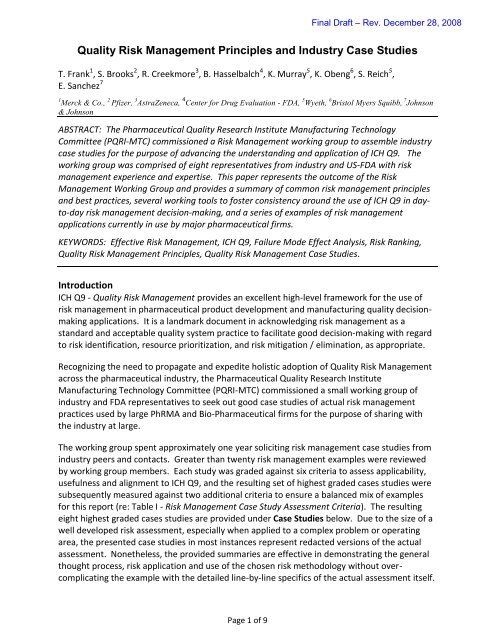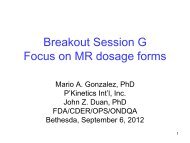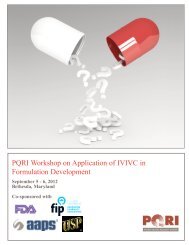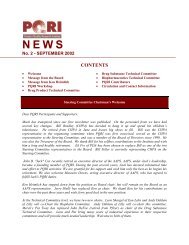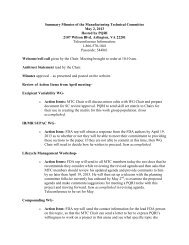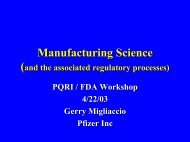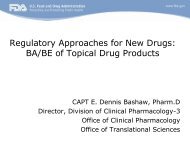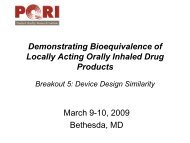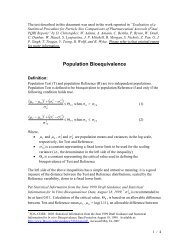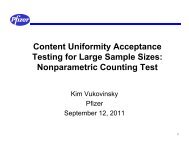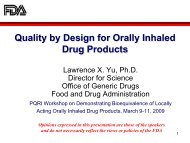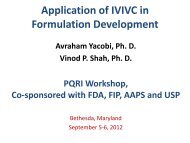Quality Risk Management Principles and Industry Case Studies - PQRI
Quality Risk Management Principles and Industry Case Studies - PQRI
Quality Risk Management Principles and Industry Case Studies - PQRI
- No tags were found...
Create successful ePaper yourself
Turn your PDF publications into a flip-book with our unique Google optimized e-Paper software.
scope <strong>and</strong> evaluate the fault modes of a particular problem <strong>and</strong> then be used to feed a HazardsAnalysis <strong>and</strong> Critical Control Point (HACCP) or similar tool to evaluate overall system control <strong>and</strong>effectiveness.A list of generally well-recognized risk management tools is provided in Table II – Common <strong>Risk</strong><strong>Management</strong> Tools, to facilitate the reader's evaluation of potential alternatives. While the listis not inclusive of all available risk assessment methodologies, it represents some of the morefrequently used approaches.Basic ToolsTable II – Common <strong>Risk</strong> <strong>Management</strong> Tools<strong>Risk</strong> <strong>Management</strong> Tool 1 Description / Attributes Potential Applications 2Diagram AnalysisFlowchartsCheck SheetsProcess MappingCause/Effect Diagrams<strong>Risk</strong> Ranking <strong>and</strong> FilteringAdvanced ToolsFault Tree Analysis (FTA)Hazard Operability Analysis (HAZOP)Hazards Analysis <strong>and</strong> Critical ControlPoints (HACCP)Failure Mode Effects Analysis (FMEA)• Simple techniques that are commonlyused to gather/organize data, structurerisk management processes, <strong>and</strong>facilitate decision making.• Method to compare <strong>and</strong> rank risks• Typically involves evaluation of multiplediverse quantitative <strong>and</strong> qualitativefactors for each risk, <strong>and</strong> weightingfactors <strong>and</strong> risk scores.• Method used to identify all root causes ofan assumed failure or problem.• Used to evaluate system/sub-systemfailures one at a time, but can combinemultiple causes of failure by identifyingcausal chains.• Relies heavily on full processunderst<strong>and</strong>ing to identify causal factors.• Tool assumes that risk events are causedby deviations from the design <strong>and</strong>operating intentions• Uses a systematic technique to helpidentify potential deviations from normaluse or design intentions.• Identify <strong>and</strong> implement process controlsthat consistently <strong>and</strong> effectively preventhazard conditions from occurring• Bottom-up approach that considers howto prevent hazards from occurring <strong>and</strong>/orpropagating• Emphasizes strength of preventivecontrols rather than ability to detect• Assumes comprehensive underst<strong>and</strong>ingof the process <strong>and</strong> that critical processparameters (CPPs) have been definedprior to initiating the assessment. Toolensures that critical process parameterswill be met.• Assesses potential failure modes forprocesses, <strong>and</strong> the probable effect onoutcomes <strong>and</strong>/or product performance.• Once failure modes are known, riskreduction actions can be applied toeliminate, reduce, or control potentialfailures.• Highly dependent upon strongunderst<strong>and</strong>ing of product, process <strong>and</strong>/orfacility under evaluation.• Output is a relative “risk score” for eachfailure mode. Compilation of observations,trends, or other empiricalinformation to support avariety of less complexdeviations, complaints,defects, or othercircumstances. Prioritize operating areas /sites for audit/assessment. Useful for situations whenthe risks <strong>and</strong> underlyingconsequences are diverse<strong>and</strong> difficult to compareusing a single tool. Investigate productcomplaints Evaluate deviations. Access manufacturingprocesses, facilities, <strong>and</strong>equipment Commonly used to evaluateprocess safety hazards. Better for preventiveapplications rather thanreactive Great precursor orcomplement to processvalidation Assessment of the efficacyof CPPs <strong>and</strong> the ability toconsistently execute themfor any process Evaluate equipment <strong>and</strong>facilities; analyze amanufacturing process toidentify high risksteps/critical parameters.1 Sample list of key risk management tools – others (not listed here) may apply for a specific application2 Examples onlyPage 4 of 9
Each risk subject <strong>and</strong> assessment warrants consideration of the applicable descriptors ofpotential risk <strong>and</strong> related consequences. Ideally, firms should establish a guidance documentahead of any risk analysis, such as the one provided in Table III - Severity Categorization Table,to help guide the risk assessment process <strong>and</strong> guide consistency in decision-making companywide.Severity ofConsequences5 -Catastrophic4 -Very Serious3 - SeriousTable III – "Severity Categorization Table"CategoryPatient Safety Regulatory Compliance Product Supply OtherUse of product willcause a serioushealthconsequence.Patient safety isaffected by productsafety that is eithera function ofproduct design or amanufacturingdefect.Use of product maycause temporary ormedically reversibleadverse healthconsequences orwhere theprobability ofserious adversehealthconsequences isremote. Degree ofseriousness issubject specific.Consent decree, productseizure, regulatoryimposedcessation ofoperations or equivalent.Major observations orregulatory warning letter.Practices/facility notaligned with regulatoryrequirements, <strong>and</strong> there isno technical justificationfor approach. GMPlicense in jeopardy ofbeing suspended orwithheld.Repeated <strong>and</strong>/or multipleminor observations.Practices <strong>and</strong>/or facilitynot aligned with currentGMP expectations, butthere is technicaljustification for the site’sapproach.Market stock out(patient impact) ofmedically significantproducts.Market stock out(patient impact) ofnon-medicallysignificant products.Subject specificissues may warrantthe consideration ofother regulatory orbusiness impactse.g.:companyreputation“current” GMPpractices withinindustryevolvingregulationsDifferentiationaround the severityof consequencesmay also need toinclude these orother areas ofinterest / potentialimpact as well.2 - Important Highly unlikely thatuse of product willcause an adversehealthconsequence.1- Noticeable No probability ofpatient impact.Few minor observations /comments.System gaps.One-off audit findings.Minor system gaps.Product back-orders(no patient impact)resulting in activeefforts to allocatesupply to avoidpatient impact.Product backorders(no patient impact)resulting intemporary shortageto wholesalers.<strong>Case</strong> <strong>Studies</strong>Eight industry examples of quality risk assessment applications are provided below. These casestudies were selected against a core set of criteria (see Introduction above) designed to identifymodels that embody the intent <strong>and</strong> spirit of ICH Q9. These examples address real-life issues,are straightforward in their application <strong>and</strong> are designed to engender a general underst<strong>and</strong>ing<strong>and</strong> appreciation of the usefulness of risk management applications in routine decision-makingopportunities. As noted above, given size <strong>and</strong> complexity, the presented case studies are oftenredacted versions of the actual assessment. Nonetheless, sufficient information has beenprovided in each example to demonstrate the concept, application, <strong>and</strong> use of fundamental riskprinciples in the assessment effort.By far, the greatest number of systems represented in the collected case studies fromcontributing industry firms were for risk assessments performed for manufacturing <strong>Quality</strong>System <strong>and</strong> Facilities & Engineering System needs (9 total case studies evaluated, of which 7 arePage 5 of 9
<strong>Risk</strong> Control - During the <strong>Risk</strong> Control stage of the QRM process, a decision is made onwhich risks, if any, require mitigation <strong>and</strong> the necessary actions are taken in order toreduce or avoid all prioritized risks, as appropriate <strong>and</strong> practical. <strong>Risk</strong> Documentation <strong>and</strong> Communication - Communication of the QRM process shouldfully integrate key stakeholders into the QRM process. By ensuring that key stakeholdersare engaged in both the data collection process for the <strong>Risk</strong> Assessment <strong>and</strong> the decisionmakingfor <strong>Risk</strong> Control, the probability of organizational buy-in <strong>and</strong> support is maximized.The output of the QRM process <strong>and</strong> associated risk analysis justifying the approach,should be documented <strong>and</strong> endorsed by the site quality unit. Additionally, thisinformation should be communicated to stakeholders for their information <strong>and</strong> to ensuretheir support. <strong>Risk</strong> Review - Appropriate systems should be in place to ensure that the output of theQRM process is periodically reviewed, as appropriate, to assess new information that mayimpact the original QRM decision. Examples of changes that may potentially impact riskof site operational systems include: changes to control systems, changes to equipment<strong>and</strong> processes, changes in suppliers/contractors, organizational restructuring, etc.1. <strong>Case</strong> Study No: RMWG-01Title: Internal GMP AuditingSystem: <strong>Quality</strong> <strong>Risk</strong> Tool: <strong>Risk</strong> Ranking & FilteringBrief Description: <strong>Risk</strong> assessment used to optimize audit schedule to focus onprioritized needs.Link: [see attached <strong>Case</strong> Study RMWG-O1 Internal GMP Auditing]2. <strong>Case</strong> Study No: RMWG-02Title: Non-Sterile Facility Cleaning RequirementsSystem: <strong>Quality</strong> <strong>Risk</strong> Tool: Decision Tree <strong>and</strong> <strong>Risk</strong> MatrixBrief Description: <strong>Risk</strong> assessment used to define minimum cleaning requirements(excludes aseptic <strong>and</strong> potent compounds).Link: [see attached <strong>Case</strong> Study RMWG-O2 Non-Sterile Facility Cleaning Requirements]3. <strong>Case</strong> Study No: RMWG-03Title: Functional Equivalence for Equipment ReplacementsSystem: Facilities & Engineering <strong>Risk</strong> Tool: FTABrief Description: <strong>Risk</strong>-based approach used to define a functional equivalenceassessment process.Link: [see attached <strong>Case</strong> Study RMWG-O3 Functional Equivalence for EquipmentReplacements]4. <strong>Case</strong> Study No: RMWG-04Title: Facility Bio-containment InactivationSystem: <strong>Quality</strong> <strong>Risk</strong> Tool: HACCPBrief Description: <strong>Risk</strong> assessment used to identify <strong>and</strong> control potential crosscontamination.Link: [see attached <strong>Case</strong> Study RMWG-O4 Facility Bio-containment Inactivation]Page 7 of 9


